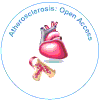Investigating the Effect of Phenylbutyrate and Valproate Supplementation on Atherosclerotic Plaque Regression in a High Fat Diet Fed LDLR-/- Mouse Model
Received Date: Mar 13, 2019 / Accepted Date: Mar 27, 2019 / Published Date: Apr 02, 2019
Abstract
Objective: Evidence suggests that Endoplasmic Reticulum (ER) stress plays a causative role in the development of atherosclerosis. Our previous studies have shown that ER stress signals through glycogen synthase kinase (GSK)-3αβ to activate pro-atherogenic pathways. The purpose of this study is to determine if small molecule inhibitors of ER stress-GSK3αβ signaling can promote the regression of existing atherosclerotic lesions.
Methods: Four-week-old female low density lipoprotein receptor deficient (LDLR-/-) mice were fed a high fat diet for 16 weeks to establish atherosclerotic lesions. A subset of mice was sacrificed at this time to set the baseline for atherosclerotic progression. The remaining mice were switched to stand chow diet (control) or a standard chow diet supplemented with phenylbutyrate, a chemical chaperone that reduces ER stress, or valproate, a branch chain fatty acid that selectively inhibits GSK3αβ. These mice were harvested at 30 weeks of age and atherosclerotic lesions were quantified and characterized.
Results: Dietary supplementation with phenylbutyrate and valproate had no effect on body weight but did significantly reduce plasma cholesterol levels. Atherosclerotic lesion areas at the aortic sinus and total atherosclerotic volumes were significantly larger in the control group compared to the baseline group, indicating that the lesions continued to grow despite the switch from a high fat diet to chow diet. The supplemented mice had significantly smaller lesions than the control group, but not the baseline group. Both phenylbutyrate and valproate supplementation reduced lesional macrophage/foam cell content and necrotic core area, and increased smooth muscle cell content and collagen content, relative to control and baseline groups. These changes are indicative of more stable atherosclerotic lesions.
Conclusion: Small molecule inhibitors of ER stress-GSK3αβ signaling do attenuate the growth of existing atherosclerotic lesions and appear to increase lesion stability. It remains unclear whether these interventions can actually promote atherosclerotic regression.
Keywords: Atherosclerosis; Mouse model; Plaque regression; Dietary supplementation; ER stress
Citation: Patel S, De Jong M, Huang A, Shi Y, Werstuck GH (2019) Investigating the Effect of Phenylbutyrate and Valproate Supplementation on Atherosclerotic Plaque Regression in a High Fat Diet Fed LDLR-/- Mouse Model. Atheroscler Open Access 4: 123.
Copyright: © 2019 Patel S, et al. This is an open-access article distributed under the terms of the Creative Commons Attribution License, which permits unrestricted use, distribution, and reproduction in any medium, provided the original author and source are credited.
Share This Article
Open Access Journals
Article Usage
- Total views: 3171
- [From(publication date): 0-2019 - Mar 31, 2025]
- Breakdown by view type
- HTML page views: 2398
- PDF downloads: 773
